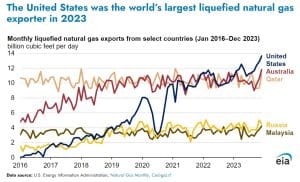Ever since Trump came to power, there have been serious speculations about the future of America from a climate perspective. We saw clean energy stocks tumbling like a pack of cards and Trump’s “drill, baby, drill” policies eventually taking shape.
Well, at this conjecture Reuters came up with an interesting report explaining that Donald Trump’s energy team is planning an aggressive agenda to reshape U.S. energy policy. He will prioritize expanding liquefied natural gas (LNG) exports, increasing offshore oil drilling, and streamlining permits for federal land projects.
These actions signal a dramatic shift from the Biden administration’s climate-focused pro-renewables policies. Let’s deep dive into what’s on Trump’s agenda…
Fast-Tracking LNG Exports, Restart Oil and Drilling
The report further highlighted that under the Biden administration, several significant LNG projects were delayed. Venture Global’s CP2, Commonwealth LNG, and Energy Transfer’s Lake Charles facility all of them are based in Louisiana. Trump wants to de-freeze and approve these projects which would send a strong message of support for the natural gas sector.
Federal records revealed,
“Five U.S. LNG export projects that have been approved by the Federal Energy Regulatory Commission are still awaiting permit approvals at the Department of Energy (DOE).”
The U.S., as the leading LNG exporter, plays a key role in global energy. With Europe seeking U.S. gas to cut reliance on Russia, Trump aims to seize the opportunity. This means there would be faster approvals, unlocking massive LNG infrastructure investments.

- EIA notes, that in 2023 the U.S. LNG exports averaged 11.9 billion cubic feet per day (Bcf/d)—a 12% increase (1.3 Bcf/d) compared with 2022.
Notably, Trump’s team also aims to accelerate oil and gas drilling off the U.S. coast and on federal lands. Federal lands currently account for a quarter of U.S. oil production and 12% of natural gas output.
During his first term, drilling permits took significantly less time to process compared to the Biden administration. This time he plans to reinstate a concrete long-term drilling plan that would expand offshore lease sales and fast-track all permit approvals to increase energy product. His focus will primarily be on regions having rich oil reserves.
Now taking about the stats, Reuters reported,
“According to federal data, oil output on federal lands and waters hit a record in 2023, while gas production reached its highest level since 2016.”
The report also revealed that Trump is most likely to persuade the IEA on pro-oil decisions. However, his advisors have urged him to suppress funding unless the IEA adopts a more pro-oil stance.
Dan Eberhart, CEO of oilfield service firm Canary said,
“I have pushed Trump in person and his team generally on pressuring the IEA to return to its core mission of energy security and to pivot away from greenwashing.”
A symbolic yet bold move would be Trump’s push to approve the Keystone XL pipeline, a project canceled downrightly by Biden. However, reviving the pipeline has challenges, as land easements have been returned and construction would require starting from scratch. Even so, Trump’s endorsement signals a commitment to fossil fuel infrastructure.
Trump’s Stance on Inflation Reduction Act: A “Green Scam”?
Prior to his win, we have read and seen all around how he openly criticized the Inflation Reduction Act (IRA), calling it a “green scam”. He also pledged to repeal it if he returned to power once again.
This bold statement has raised questions about the future of the Biden administration’s $369 billion energy transition agenda. While his rhetoric may signal trouble for renewable energy sectors like electric vehicles (EVs) and wind power, Trump’s track record suggests a more nuanced approach to industrial policy and critical mineral supply chains.
But Critical Minerals are Safe in Trump’s Hands…
The IRA has funneled significant resources into renewable energy, but it also supports rebuilding America’s industrial base. For instance, $75 million was allocated to upgrade Constellium’s aluminum rolling mill in West Virginia. Efforts like these align with Trump’s earlier policies emphasizing industrial revitalization and reduced reliance on foreign nations for critical resources.
In 2020, Trump declared the United States’ dependence on foreign critical minerals a national emergency. A second Trump administration is unlikely to abandon this push for metal self-sufficiency. Instead, he may amplify efforts to boost domestic production of key materials like aluminum, nickel, and lithium.
The good news is cross-party consensus on this issue suggests that funding for industrial projects tied to critical minerals may be safe, even under a Republican administration.
America First: China in Scrutiny
Both the Department of Energy (DOE) and the Department of Defense (DOD) have prioritized investments in rebuilding U.S. metals capacity. While the DOE focuses on EV battery metals like lithium, the DOD has diversified its investments toward antimony to zirconium. All these moves align toward reducing dependency on China for critical minerals.
Projects like Talon Metals’ Tamarack nickel initiative in Minnesota have already received federal funding. However, the nickel market faces significant challenges due to Indonesia’s mining boom, which has driven down prices. Most of Indonesia’s nickel production is controlled by Chinese entities, complicating matters for U.S. companies like Ford, which are sourcing Indonesian nickel for EV batteries.
Trump’s “America First” philosophy highlights his strong opposition to critical metal imports from China. His administration will probably scrutinize even joint ventures like Ford’s collaboration with Indonesia’s Vale and Huayou Cobalt. Even if these ventures technically qualify for IRA subsidies, their ties to Chinese supply chains may face new barriers under his administration.
Can America Be Great Again?
Despite Trump’s bitterness about the IRA, his administration may continue supporting parts of it that align with domestic industrial goals. Consequently building U.S. mineral independence will significantly reduce reliance on China and secure advanced technology materials.
Concisely, this means a second Trump presidency might prioritize America’s self-sufficiency while addressing IRA’s initiatives to fit in his “Make America Great Again” agenda.
This report suggests that Trump’s policies could possibly reinforce a robust U.S. oil, gas, and critical minerals industry. While his decision on renewables like EVs and tariffs on imports are still uncertain, he prioritizes critical minerals which is assuring for national security and economic competitiveness.
Sources:

